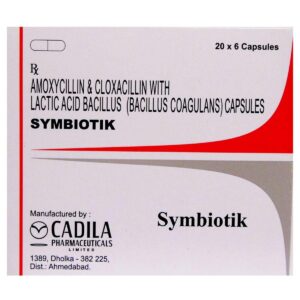AMOXYCILLIN + CLOXACILLIN + LACTO BACILLUS
Amoxycillin: Amoxicillin is a broad-spectrum antibiotic that belongs to the class of drugs known as penicillins. It is commonly used to treat a variety of bacterial infections such as respiratory tract infections, ear infections, urinary tract infections, skin infections, and certain sexually transmitted diseases.
The mechanism of action of amoxicillin involves inhibiting the growth of bacteria by targeting their cell walls. It does this by interfering with the synthesis of peptidoglycan, a key component of bacterial cell walls. This weakens the cell walls, eventually leading to their rupture and the death of the bacteria.
The usual recommended dose of amoxicillin varies depending on the age, weight, and severity of the infection being treated. The dose for adults typically ranges from 250 mg to 500 mg taken orally every 8 hours, or 500 mg to 875 mg every 12 hours for more severe infections. For children, the dose is determined based on their weight and is usually administered as a liquid suspension.
Some common side effects of amoxicillin include diarrhea, nausea, vomiting, stomach pain, and skin rash. These side effects usually occur infrequently and are generally mild. However, more serious side effects can occur, such as severe allergic reactions (e.g., anaphylaxis), liver problems, and blood disorders. It’s important to seek medical attention if any severe or unusual side effects are experienced.
As with any antibiotic, it is important to take the full course of prescribed amoxicillin even if symptoms improve before completing the treatment. This helps to ensure the complete eradication of the infection and prevent the development of antibiotic resistance.
Cloxacillin: Cloxacillin is an antibiotic drug that belongs to the class of drugs known as penicillins. It is commonly used to treat various bacterial infections caused by gram-positive bacteria, including skin and soft tissue infections, respiratory tract infections, and bone and joint infections.
The mechanism of action of Cloxacillin involves inhibiting the formation of the bacterial cell wall, leading to bacterial cell death. It specifically targets and binds to penicillin-binding proteins (PBPs) on the bacterial cell membrane, preventing the cross-linking of peptidoglycan chains and weakening the cell wall structure. This weakens the bacteria, making it more susceptible to destruction by the immune system.
Cloxacillin is typically administered orally or intravenously, with dosages varying depending on the severity of the infection and the patient’s age and weight. The usual adult oral dose is 250-500 mg every 6 hours, while the usual adult intravenous dose is 500 mg to 2 grams every 4-6 hours. The dose for children is based on their weight and is typically lower than the adult dose.
Like any medication, Cloxacillin may cause some side effects. Common side effects include diarrhea, nausea, vomiting, rash, and itching. These side effects are generally mild and tolerable. However, serious side effects such as severe allergic reactions, liver problems, and blood disorders may occur in rare cases. It is important to seek medical attention immediately if any severe side effects are experienced.
Furthermore, since Cloxacillin is a penicillin-class antibiotic, there is a potential risk of hypersensitivity reactions, especially in individuals with a history of penicillin allergy. It is crucial to inform the healthcare provider of any known allergies before starting treatment with Cloxacillin.
Overall, Cloxacillin is an effective antibiotic commonly used to treat bacterial infections. It is essential to follow the prescribed dosage and duration of treatment to ensure successful outcomes and minimize the risk of side effects.
Lacto Bacillus: Lactobacillus is a type of beneficial bacteria that is commonly found in the human digestive system. It is also used as a probiotic supplement to restore the natural balance of bacteria in the gut.
The main use of Lactobacillus is to promote healthy digestion and support the immune system. It is thought to work by inhibiting the growth of harmful bacteria in the gastrointestinal tract and producing lactic acid, which helps to maintain a slightly acidic environment that is unfavorable to pathogens.
Lactobacillus is available in various forms, including capsules, tablets, powders, and yogurts. The recommended dose may vary depending on the specific product and the condition being treated. It is important to follow the instructions provided by the manufacturer or healthcare professional.
In general, Lactobacillus is considered safe for most individuals. However, some people may experience mild side effects such as bloating, gas, or diarrhea. These side effects are usually temporary and subside on their own as the body adjusts to the supplement. If these symptoms persist or worsen, it is advisable to consult a healthcare professional.
It is worth noting that individuals with compromised immune systems or those who are critically ill should consult their healthcare provider before taking Lactobacillus or any other probiotic supplement.
Overall, Lactobacillus is a commonly used probiotic that may help support digestive health and boost the immune system. As with any medication or supplement, it is important to consult a healthcare professional before starting Lactobacillus to ensure it is appropriate for individual circumstances.

